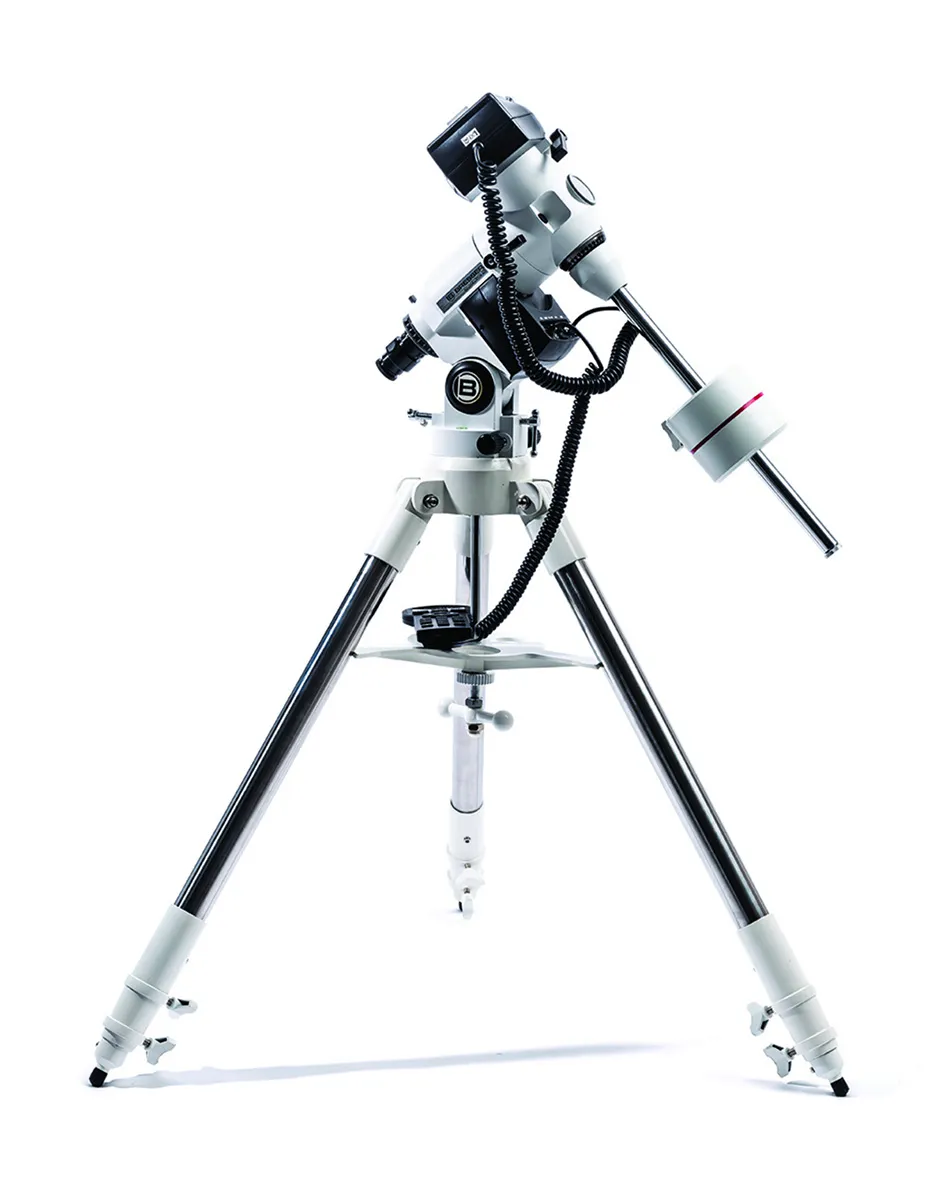Price: £499.00
Weight: 9.2kg
Supplier: Telescope House
Telephone: 01342 837098
Website: www.telescopehouse.com
The EQ5 is a German equatorial mount that has become the design of choice for use with medium-sized telescopes.
Bresser’s EXOS 2 Go-To mount continues in this tradition, and can be used for both visual observing and astrophotography.
The mount is supplied with a stainless steel tripod, hand controller, 4.5kg counterweight, accessory leg brace and a battery case that takes eight D batteries (which are not supplied).
It also features an in-built illuminated polar scope.
Assembly was reasonably straightforward, with the main body attaching to the tripod and the hand controller to the mount head.
The mount is solidly built and once attached to the tripod we found it a very sturdy base for a range of our own scopes, including a 3-inch f/5 apo refractor, a 5-inch f/9.4 achromatic refractor and a 7-inch f/15 Maksutov.
The manufacturer recommends a maximum load capacity of up to 13kg for visual use; if you are considering this mount for imaging, we would suggest a load limit of 10kg for smooth tracking.
The saddle is Vixen style, but for the sort of telescopes you would use with it this is no problem: its large knurled locking knob held all the telescopes we attached to it firmly and securely.
Setting up
Polar alignment was straightforward using the in-built polarscope and the latitude and azimuth adjustment bolts.
The polarscope reticule has etched guides for both the southern and northern hemispheres, and an illuminator to help with the alignment process.
Power is supplied by either the aforementioned battery case or a 12V mains power adaptor (sold separately).
Note that the power connector is not the same type commonly found on other popular mounts, but a suitable cigar type power lead with the correct connector can be purchased from the supplier.
As we didn’t have this cable, we used our own five-in-one power pack with inverter and a mains adaptor: even after four hours continuous use, we saw little drop in its power levels.
It would be fair to say that this mount is not power hungry.

The hand controller supplied with the review mount was the Meade Autostar, which has red backlit buttons and a two-line red LCD screen.
Its database contains more than 30,000 objects, plus a tour option and several alignment choices to help you achieve accurate slewing.
For visual observing the ‘easy’ (where stars are selected for you) and two-star alignments were sufficient, but the three-star alignment gives more accurate slewing for astrophotography.
After the review period we learned that Bresser is replacing the Meade Autostar with another handset of its own design, the newer Bresser Star Tracker.
This hand controller features a larger, easier to read LCD screen, with an eight-line display and a dedicated ST-4 port for guiding purposes.
The object database is also larger, with 100,000 objects as opposed to the Meade Autostar’s 30,000.
In action, the mount performed well: our tracking and slew tests were very good and though we did find the high slew rate to be quite noisy, once on target the mount was exceedingly quiet.
We can certainly recommend the EXOS 2 for beginners and intermediate users alike, being simple to set up, accurate in operation and a joy to use.
Tight tracking
For our Go-To and tracking tests we chose the handset’s three-star alignment option to get the best possible results then selected a range of objects to slew to and track.
With our 5-inch f/9.4 achromat and our 26mm eyepiece we selected the Orion Nebula and pressed ‘Go-To’: the mount placed it almost spot on the centre of the view.
We did this for the Cigar Galaxy in Ursa Major and again it was only just off centre.
For a longer test, we placed the star Aldebaran in the centre of the field of view and left the system to track it.
When we returned an hour later, Aldebaran had only drifted off centre by a small distance.
After swapping to a 3-inch apo refractor and attaching a DSLR, we were able to record two-minute exposures with very little trailing.
Latitude and azimuth adjustment
Adjusting latitude and azimuth was comparatively easy even when wearing gloves on a frosty night.
The latitude scale ranges from 0º to 90º and was easy to read as you carry out polar alignment.
We also found the arrangement sturdy when everything was locked in place.
Polarscope
Achieving accurate polar alignment is vital for ensuring accurate slewing and good tracking during long exposure astrophotography.
The polarscope has an illuminated LED and a single graduated reticule for aligning with the pole.
With with the aid of suitable computer software or a smartphone app, good alignment can be achieved.
Tripod
The variable-height field tripod has stainless steel legs with a spreader bar brace; the brace doubles as an accessory tray that can house two 1.25-inch eyepieces and one 2-inch eyepiece.
Each leg also has two locking nuts for when the legs are extended.
We found the tripod to be sturdy and stable.
Hand controller
The hand controller of our review system was the Meade Autostar.
It has a two-line red LED display and 30,000-object database, which includes the Messier, Caldwell and NGC/IC catalogues plus a host of other targets.
Ports
The body of the RA axis houses four ports for connectivity in one convenient section: one for the hand controller, one for power, one for the dec. cable and an aux port for computer control or autoguiding.
This review originally appeared in the February 2015 issue of BBC Sky at Night Magazine.
